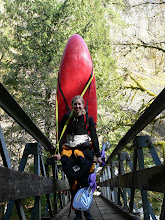The
Grand Canyon of the Rio Maranon is spectacular. Giant wave trains
weave their way through towering red walls. There are plentiful white
sandy beaches for camping and side canyons with narrows and
waterfalls for exploring. With cactus and ancient granaries clinging
to the rocky slopes, it is every bit as scenic and wonderful as the
Grand Canyon of the Colorado. The main differences are that the Rio
Maranon is free flowing and the region is inhabited. Rural villages
dot the steep mountain tops and herds of livestock graze along the
river corridor. My husband, Drew, and I were lucky to spend a week on
the Upper Grand Canyon over Christmas where we experienced the
magnificence of the canyon first hand. We met many friendly locals
along the way while they were crossing a tributary in a cable car or
navigating the flat water in a wooden raft.
Unfortunately,
like many other remote, self-reliant, indigenous communities of Peru,
the people of the Maranon are at risk of losing their land to
development and exploitation of resources. Lower sections of the
river are inhabited by the Aguaruna, the second largest indigenous group
of the Peruvian Amazon. Drew noted that these farmers, hunters, and fishermen are one of the only groups to successfully resist the Inca and
Spanish conquests and they still inhabit their native, preconquest
land1.
With little representation by the Peruvian government, the people of
the Maranon are now fighting a battle to resist a series of 20
proposed hydroelectric dams that would devastate their land and way
of life.
The
Rio Maranon is one of the key tributaries of the Amazon and the dam
project will halt flow through the entire length of the Andes
section, causing detrimental environmental effects and displacing
thousands of inhabitants2.
Two dams are already in the advanced stages of planning2.
Plans for the dam project include diverting water for irrigation of
distant regions, and generating electricity for mining development in
the Andes and energy exportation to Brazil3.
I
live in an area of the world where the ecosystem and traditional
culture of native people have suffered due to hydroelectric dam
development. I hope the people
of the Maranon will have a different ending to their story. If you feel the same way, please contact Peruvian President Ollanta Humala to voice opposition to the dams. For his contact and more information about the dam project visit:
http://www.sierrarios.org/Peru/SaveRioMaranon.html#Anchor-From-11481
http://www.sierrarios.org/Peru/SaveRioMaranon.html#Anchor-From-11481
Also, please consider supporting Sierra
Rios and International Rivers, two conservation organizations that
are working to halt dam development on the Rio Maranon. To
join Sierra Rios or get more information about river trips on the Rio
Maranon visit:
http://sierrarios.org/GuidedTrips/RaftTripInfo_Maranon.html
Drew's exciting account of our Christmas adventure on the Upper Grand Canyon of the Rio Maranon can be found here: http://www.hoodrivernews.com/news/2015/jan/21/travelogue-part-one-week-rio-maranon/
Drew's exciting account of our Christmas adventure on the Upper Grand Canyon of the Rio Maranon can be found here: http://www.hoodrivernews.com/news/2015/jan/21/travelogue-part-one-week-rio-maranon/
References
1McCarthy,
C. (2013). Peru
(8th
ed., p. 518). Footscray, Vic.: Lonely Planet.










No comments:
Post a Comment